What's new
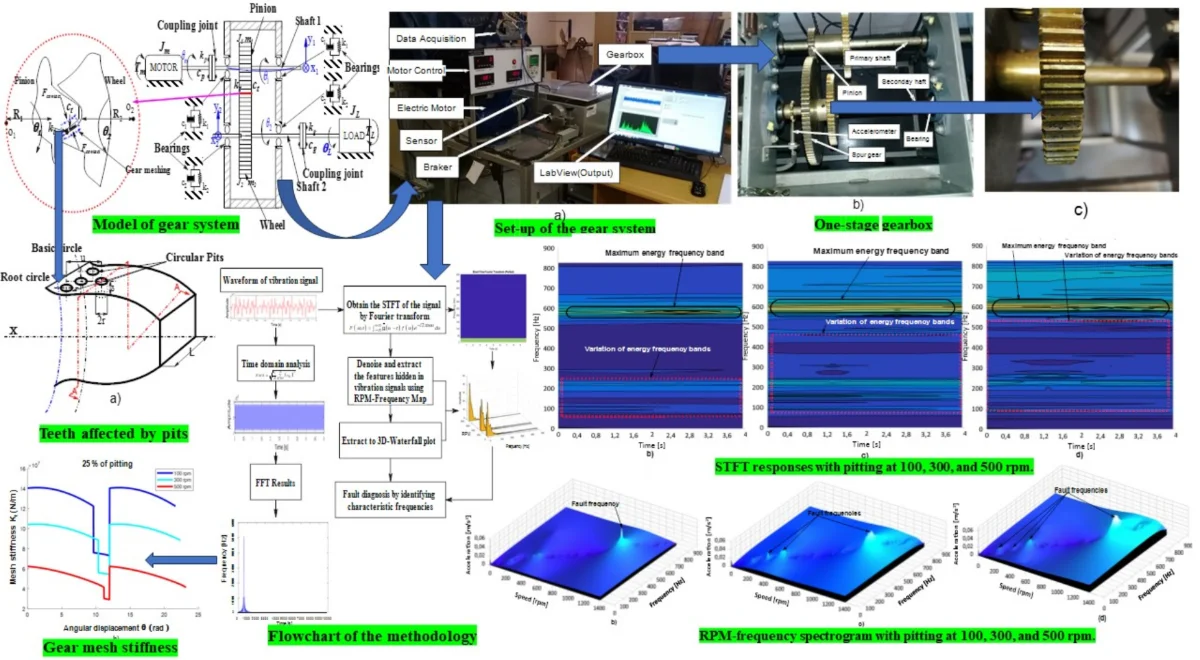
Editor's pick
Research Article
Experimental study and comparative analysis of pitting fault in spur gear system
By Kemajou Herbert Yakeu Happi, Bernard Xavier Tchomeni Kouejou, Alfayo Anyika Alugongo
This paper uses a dynamic six-degree-of-freedom model that considers torsional and lateral motions to predict the impact of pitting on vibration parameters in a spur gearbox for various operating speeds and torque loads. The study examines the dynamic characteristics of a gearbox with localized pitting damage on a single gear tooth using theoretical and experimental approaches. The research analyzes the forced vibrations of a single-stage spur gear system with pitting damage, which includes variations in mesh stiffness, damping, and gear error excitation, to identify symptoms of default. The equation of motion for the rotary gearbox system is established using the Lagrangian method in tandem with Short-Time Fourier Transform (STFT) and frequency-RPM map fault diagnosis. During real-time vibration monitoring, vibration signals are captured via accelerometers and processed in both the time and frequency domains using the LabVIEW data acquisition signal processing package to extract diagnostic information. The experimental findings demonstrate how vibration analysis combined with time-frequency processing can recognize machine conditions even in harsh operational conditions. Moreover, the experimental results indicate a significant similarity with the theoretical analysis and validate the effectiveness of the RPM frequency technique-based pitting detection method, which can be an asset in gear fault monitoring.
September 14, 2023
Vibration Engineering
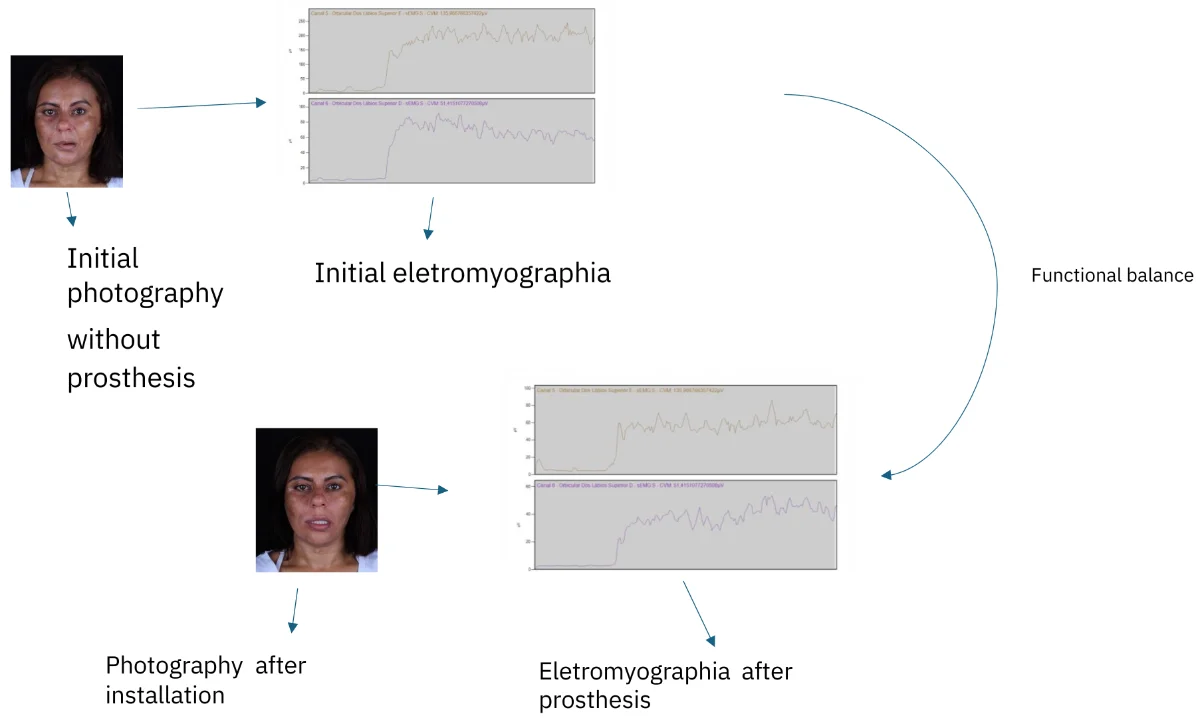
Research Article
The impact of occlusal plane rehabilitation on the face of a patient with traumatic peripheral facial paralysis by Timpanic jugular tumor-case report
The musculature of the face is innervated by cranial nerves, each with a motor, sensory and/or both function. The Facial nerve (FN) is responsible for the motor innervation of the muscles of the face. Some branches of the trigeminal nerve are responsible for the sensory part of the facial muscles and other branches act on the motor part of the chewing muscles. Traumatic Facial Paralysis (TFP) is the one where there was section or traction or compression or ischemia of the FN, in surgery for tumor resection or trauma in general. In this case occurs the nerve’s section in one surgery. Facial Paralysis (FP) can be evaluated subjectively through the House and Brackmann classification scale (HB) [1]. It is considered a chronic FP when it persists for a period longer than 6 months and leaves sequelae, such as synkinesis, contractures and lack of complete innervation of some nerve branches. Some patients who evolve with chronic FP may also evolve with alteration of the occlusal plane. The occlusal plane is the meeting point between the antagonist teeth, plane that is in the final stop of the masticatory cycle. The rehabilitation of this plan is performed according to the needs of each patient, in this case was made through implant prostheses.
April 29, 2024
Orthopedics
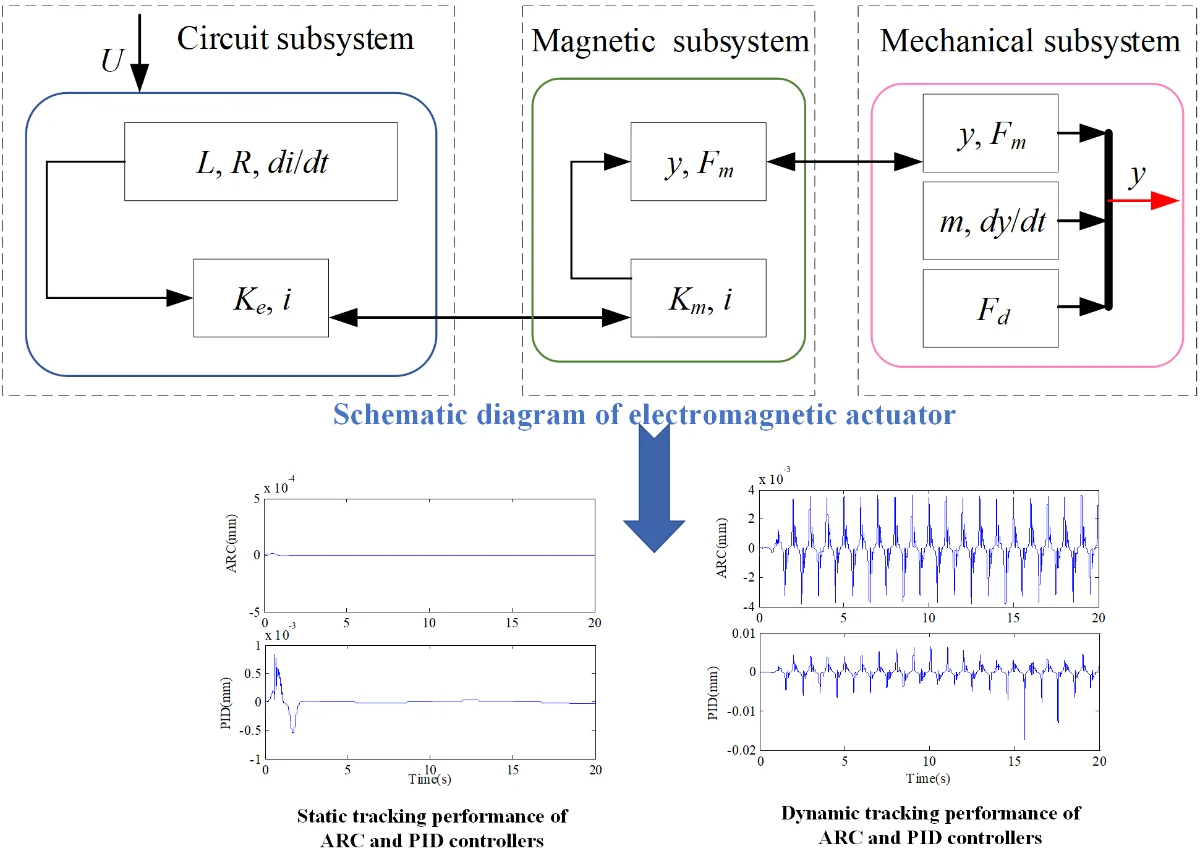
Research Article
Adaptive robust control of electromagnetic actuators with friction nonlinearity and uncertainty compensation
Friction nonlinearity and uncertainty are the main factors affecting the highly performance control of electromagnetic actuators. In this paper, a nonlinear adaptive robust control strategy is proposed of electromagnetic actuators with friction nonlinearity and uncertainty compensation. First, the dynamical model of the electromagnetic actuator is established considering nonlinearity and uncertainty. Then, an adaptive robust controller is designed based on the continuously differentiable friction model to ensure that the control input is continuously and bounded. In the design of the controller, the unfavorable effects of unknown parameters in the electromagnetic actuator are eliminated by constructing a parameter adaptive law. Meanwhile, in order to improve the tracking accuracy of the electromagnetic actuator, a nonlinear robust control law is designed to ensure the robustness of the controller. The stability analysis by Lyapunov function shows that the asymptotic tracking effect can be obtained when only parameter uncertainty exists in the closed-loop system of the electromagnetic actuator, and the consistent bounded stability can be ensured when the system also exists uncertain nonlinearity. Extensive comparative results verify the effectiveness of the proposed control method.
April 29, 2024
Informatics
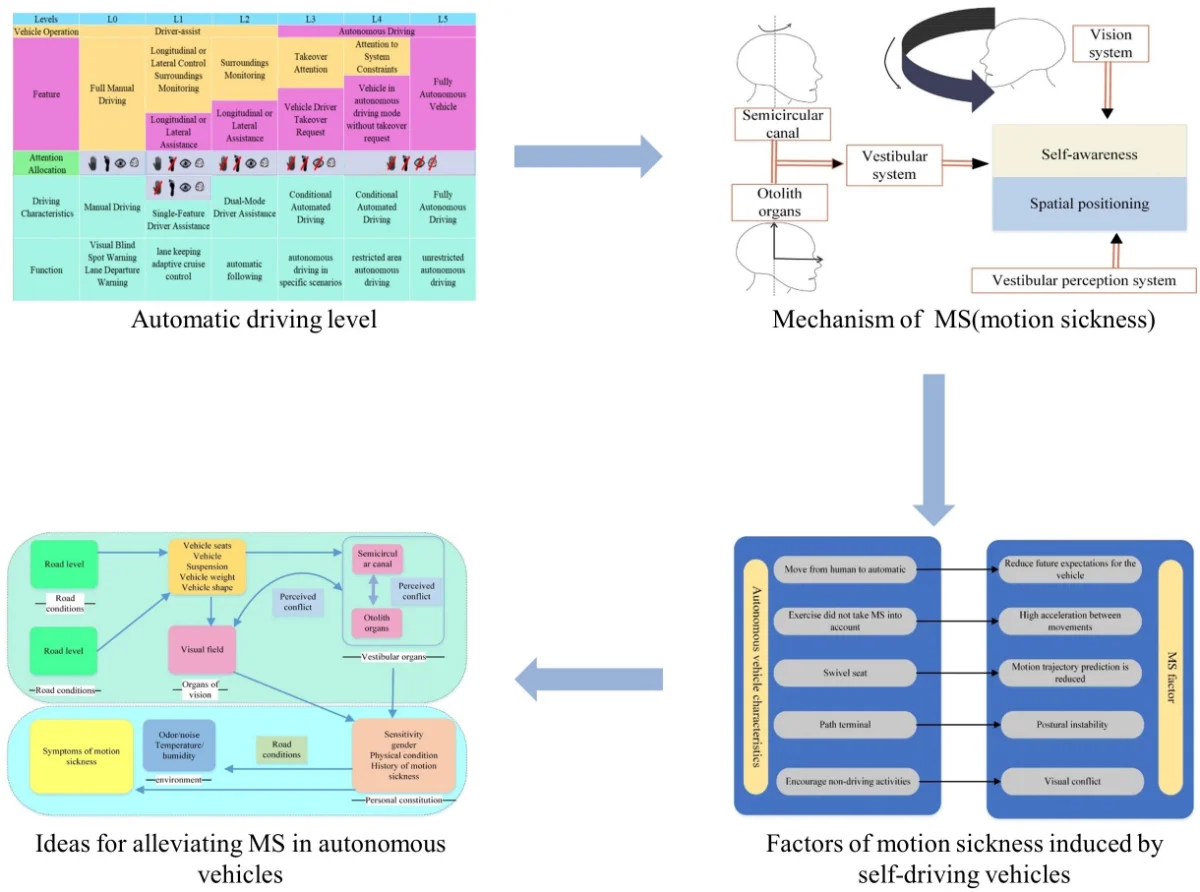
Research Article
A review on motion sickness of autonomous driving vehicles
The objective of this study is to investigate the symptoms, types, etiology, and assessment methods of motion sickness in autonomous vehicles in order to gain a comprehensive understanding of its occurrence mechanism and emphasize the significance of enhancing autonomous vehicle algorithms for improved ride comfort. Thus, this paper provides a synthesis and discussion of various theories while exploring strategies for mitigating motion sickness from three perspectives: passengers, vehicles, and external equipment. Firstly, it summarizes the clinical manifestations and classification of motion sickness while conducting an in-depth analysis of associated factors. Secondly, it evaluates different approaches for quantitatively measuring the severity and extent of motion sickness. Subsequently, it analyzes the reasons behind increased motion sickness caused by autonomous vehicles and emphasizes the importance of algorithmic improvements to enhance travel comfort. Finally, mitigation strategies are proposed considering passengers' needs as well as advancements in accurate motion prediction models and optimization techniques for autonomous planning and control algorithms that can effectively reduce the risk of motion sickness. As application scenarios for autonomous technology continue to expand, meeting user requirements while ensuring safety has become a benchmark for assessing technical proficiency. Therefore, promoting unmanned travel services necessitates a thorough analysis of existing issues related to autonomous technology along with prioritizing algorithm design enhancements through effective means to achieve an enhanced user experience.
April 29, 2024
Vibration Engineering
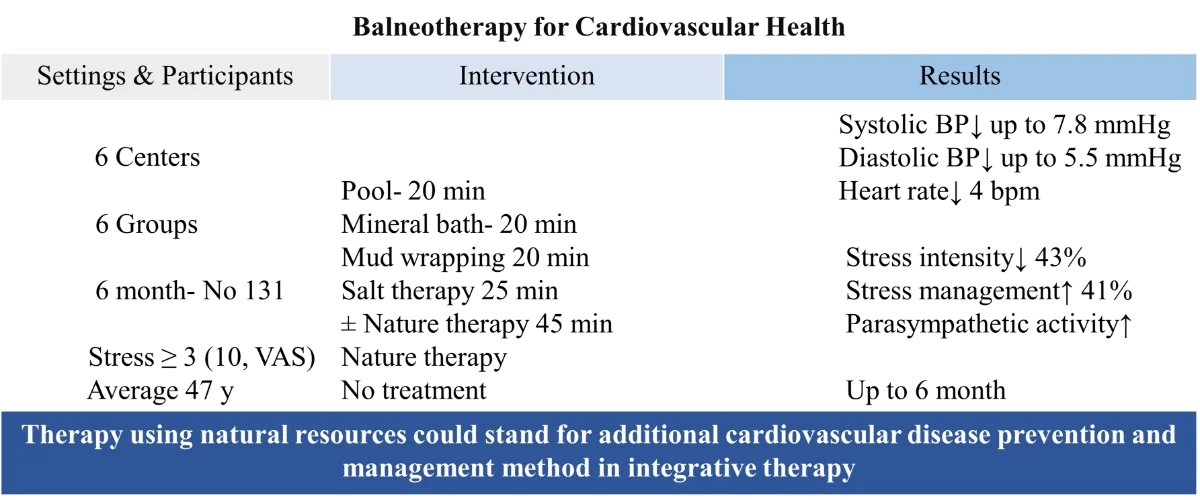
Research Article
Natural resources can help reducing cardiovascular risk: randomized controlled study
Cardiovascular diseases are the leading cause of death globally accounting for 32 % of all global deaths. Addressing modifiable risk factors, including hypertension and stress, remains paramount in the prevention of CVD. This study aimed to assess the impact of the balneotherapy on blood pressure, heart rate, electrocardiogram parameters, utilization of antihypertensive medications, and stress levels. Methodology. Multicenter randomized controlled single-blind parallel group trial was made in 6 Lithuania resort centers. 373 participants with the stress level > 3 (10, VAS) randomly divided into 6 groups in two clusters for receiving a 6- or 11-day complex treatment using natural resources – mineral waters, peloids, salt, nature therapy; follow-up period was 6 months. The BP, HR, ECG, stress level and other parameters were analyzed in 131 participants who passed a full course of investigation. Results. The significant reduction of systolic blood pressure after treatment (7.8 mmHg) and during 6 months (7.3 mmHg) together with diastolic 5.5 after 6 month and heart rate (4 b/min) was achieved in 11-day ambulatory balneotherapy group. Increase in the activity of the parasympathetic nervous system was observed, which is reflected by an increase in the duration of the ECG indicators. The stress level decreased by up to 43%, and stress management improved by up to 41% following inpatient treatment. Conclusion. Therapy using natural resources could stand for additional cardiovascular disease prevention and management method in integrative therapy.
April 29, 2024
Public Health
Latest from engineering
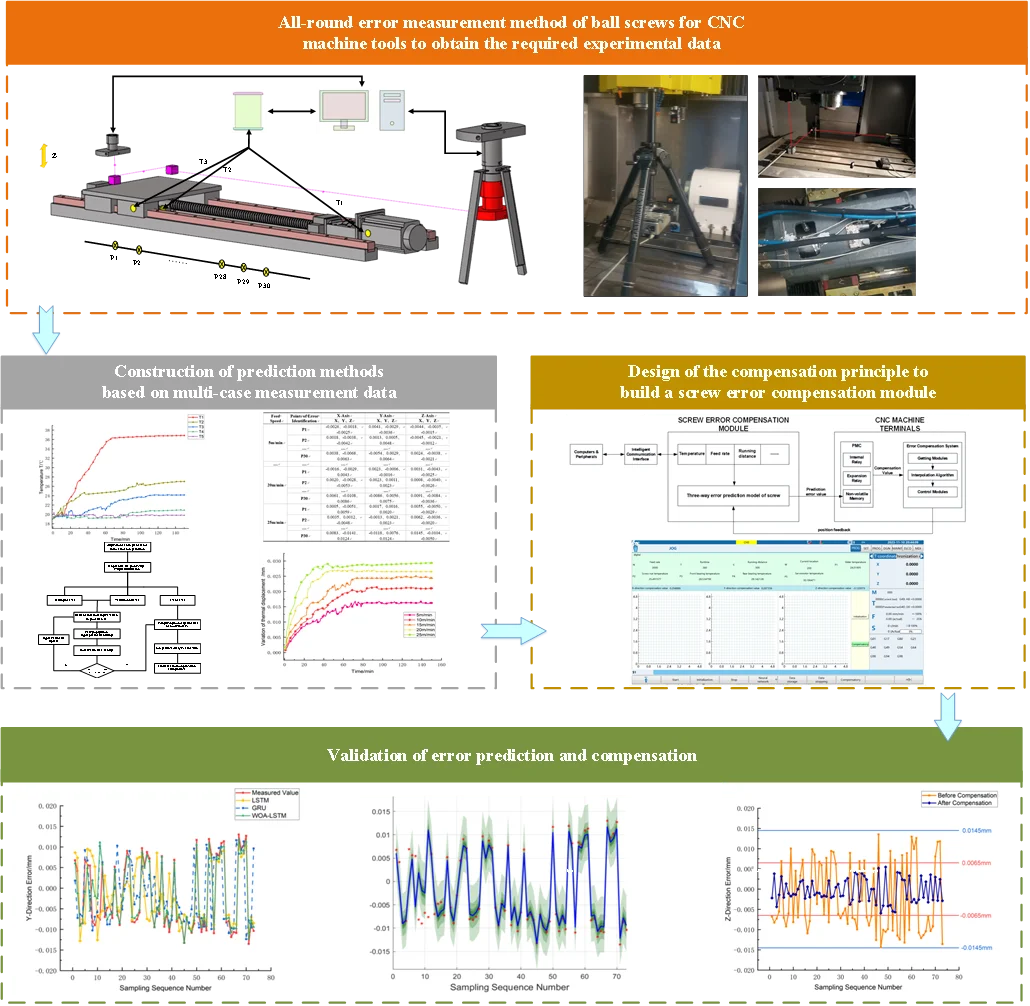
Research Article
A ball screw all-round error compensation technology based on novel hybrid deep learning for CNC machine tool
Considering the detrimental impact of thermal phenomena on the geometric precision of machine tools, a machine tool ball screw’s omni-directional error model is created using the LSTM neural network algorithm. Subsequently, the machine tool ball screw's omni-directional error compensation module is devised by combining the core functions of the Huazhong numerical control system with the visual programming environment of QT and the numerical computation capability of Matlab. To enhance the practicality and accuracy of the compensation model, this study has employed the Whale Optimization Algorithm (WOA) to optimize the parameters of the LSTM model. This has resulted in an improvement in the model's generalization ability and prediction performance, making it more effective. During the experimental validation phase, the Z-axis error of the machine tool was practically operated and analyzed using the compensation method. Results manifestly show that, after employing the compensation method, the peak amplitude of the Z-axis error fluctuations have been notably curtailed to ±0.006 mm – a considerable reduction compared to the initial error bandwidth of ±0.0145 mm. These empirical findings substantiate the efficacy of the proposed compensation strategy in substantially boosting the machining precision of products, thus furnishing a substantial and instructive benchmark for future inquiries into CNC machine tool error compensation technologies.
April 21, 2024
Vibration Engineering
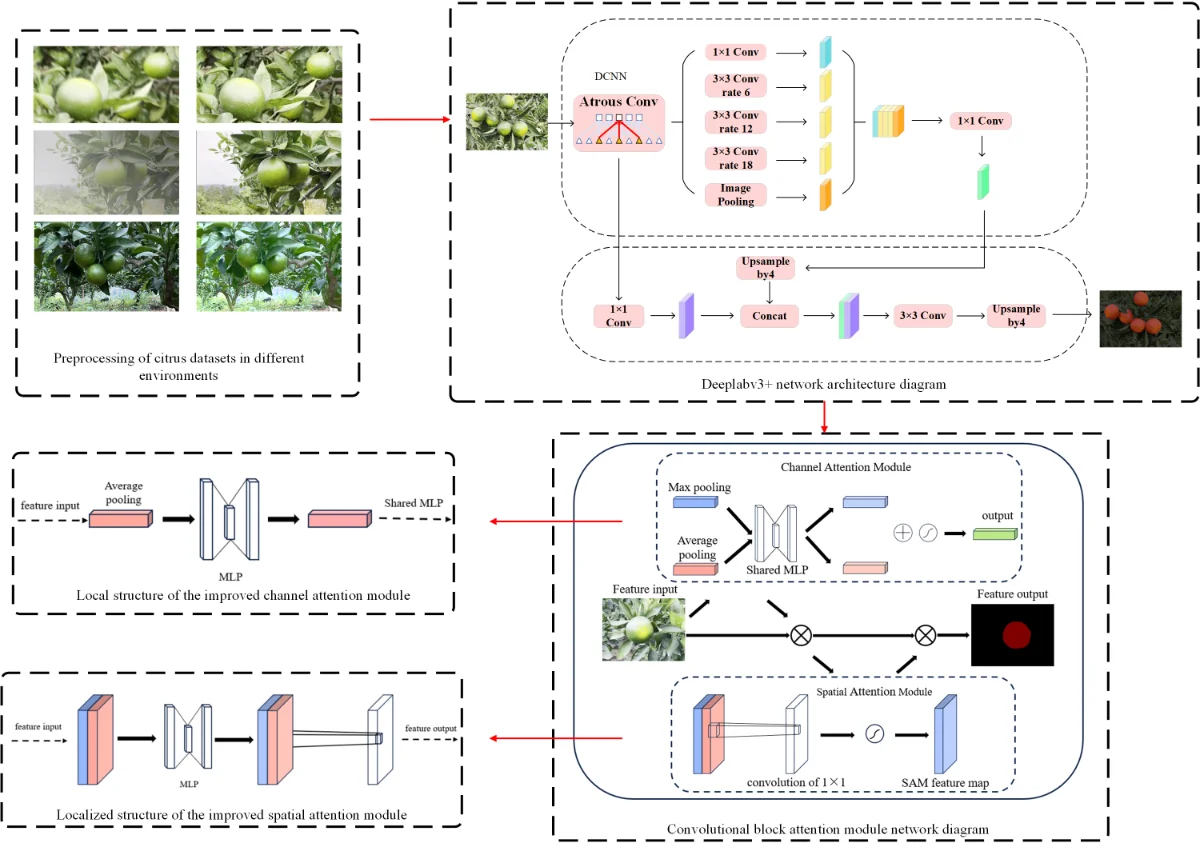
Research Article
Research on citrus segmentation algorithm based on complex environment
Aiming to address the low efficiency of current deep learning algorithms for segmenting citrus in complex environments, this paper proposes a study on citrus segmentation algorithms based on a multi-scale attention mechanism. The DeepLab V3+ network model was utilized as the primary framework and enhanced to suit the characteristics of the citrus dataset. In this paper, we will introduce a more sophisticated multi-scale attention mechanism to enhance the neural network’s capacity to perceive information at different scales, thus improving the model’s performance in handling complex scenes and multi-scale objects. The DeepLab V3+ network addresses the challenges of low segmentation accuracy and inadequate refinement of segmentation edges when segmenting citrus in complex scenes, and the experimental results demonstrate that the improved algorithm in this paper achieves 96.8 % in the performance index of MioU and 98.4 % in the performance index of MPA, which improves the segmentation effectiveness to a significant degree.
April 21, 2024
Informatics
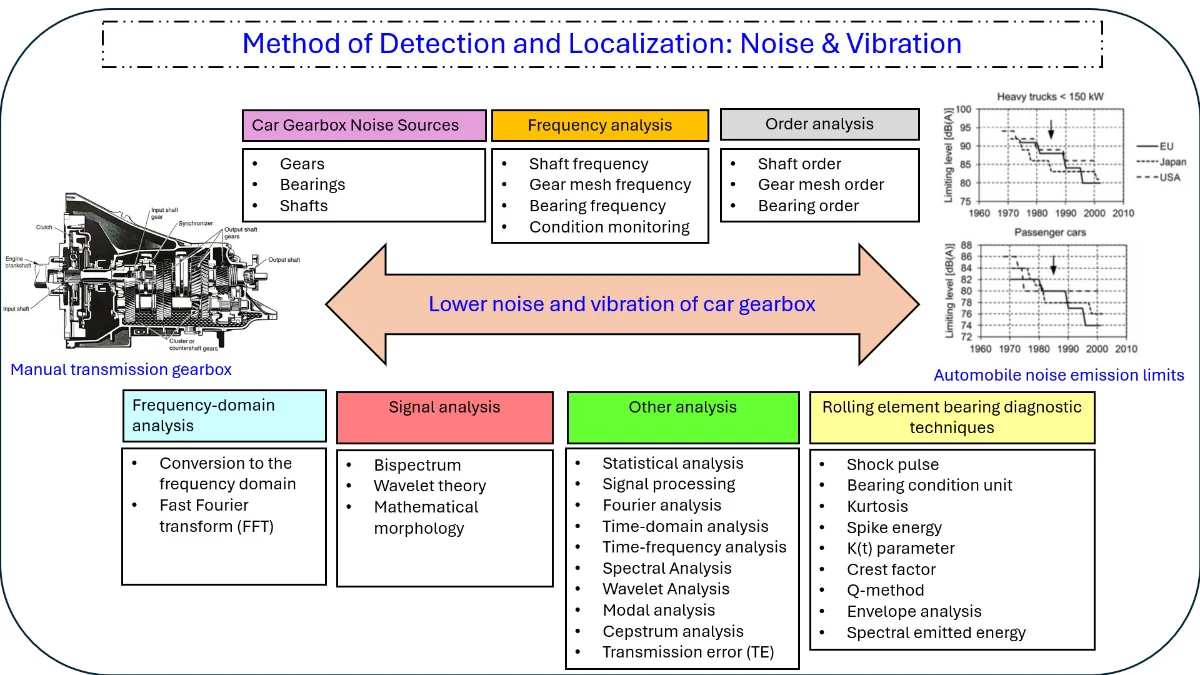
Research Article
Methods of detection and localization of the sources of noise and vibration on car gearboxes: a review
One of the primary sources of noise and vibration in automobiles is gearboxes. Shafts, gears, and bearings are the main causes of noise and vibration in vehicle gearboxes. Various studies have reported that vibrations’ root cause is bearing excitation. Besides bearing fatal defects or extreme structure resonance amplification, gear mesh is the primary source of high-frequency vibration and noise, even in newly built units. Gear damage detection is frequently crucial in automotive gearboxes and vehicle safety. Furthermore, vibrations caused by shaft imbalances, shaft misalignments, and other factors can cause noise and vibrations in the drivetrain's transfer path. In addition, the vibration of an automobile gearbox is closely related to poor design, construction quality, and production accuracy. This paper reviewed previous research and methods on car gearboxes for conventional vehicles. It was obvious that frequency analysis and order analysis were commonly used in noise and vibration analysis on car gearboxes. Envelope analysis is usually used to analyze bearing faults. Finally, rolling-element bearing diagnostic techniques were also reviewed.
April 14, 2024
Applied Mathematics
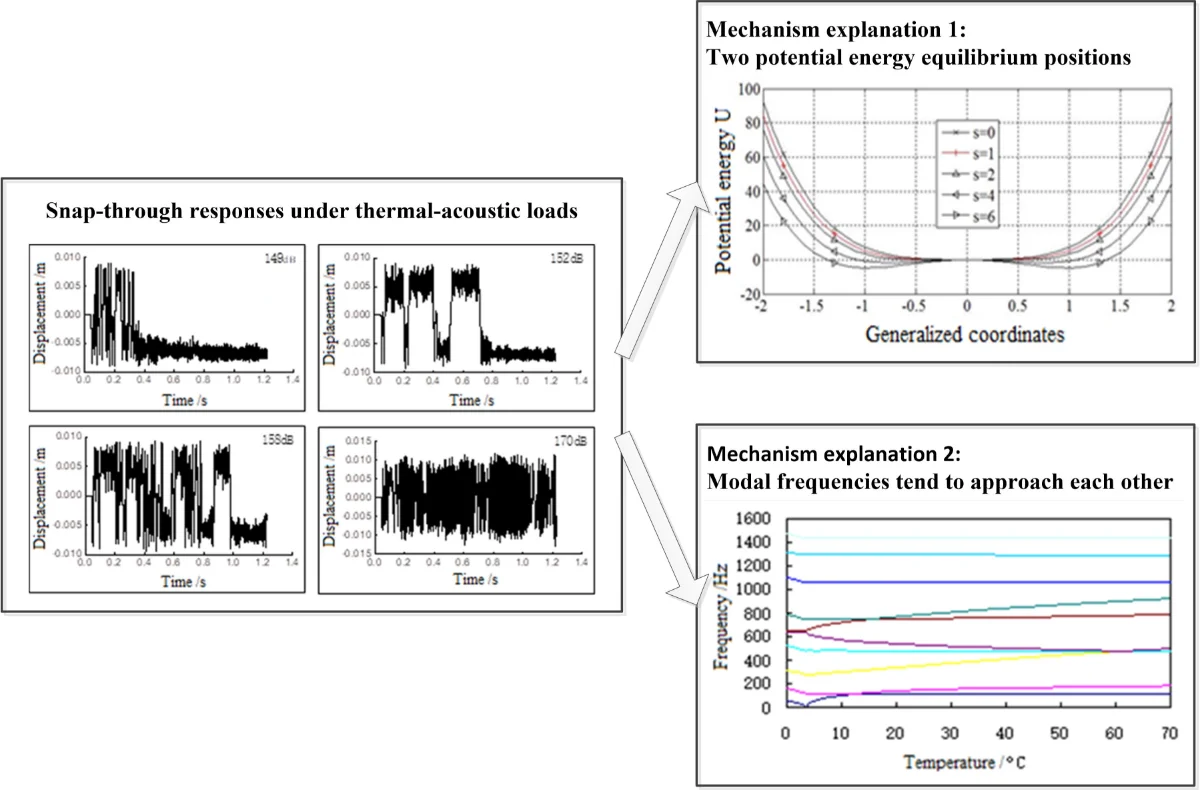
Research Article
Acoustic vibration analysis of high-temperature thin-walled structures
Advanced aerospace structures are subjected to extremely harsh working environment, including of mechanical, acoustic, thermal, and aerodynamic loads. These combined loads can make the structures exhibit complex response, which has already attracted increasing concern in the design of advanced aerospace structures. To tackle the problem, a finite element model (FEM) by discretizing the theoretical differential equation is established to calculate the dynamic response of thin-walled structures under combined thermal and acoustic loads. The numerical analysis indicates that three types of nonlinear responses of the thin plate under combined thermal-acoustic loads are obtained, and the mechanism of snap-through is revealed through two ways: thermal buckling analysis and thermal modal analysis. which can be used to explain the nonlinear response characteristics.
April 4, 2024
Public Health
Recently published
Research article
April 4, 2024
Investigation of fracture behavior and mechanical properties of epoxy composites supported with MWCNTs microscopically
By Abdelsalam Abdelhussein, Guolai Yang, Emad Kamil Hussein, Lei Li, Barhm Mohamad
Recently published
Research article
March 2, 2024
Testing the effect of functional orthopedic appliance Simões network 6 (SN6) through surface electromyography on rest mandibular position – a pilot study
By Sergio Polízio Terçarolli, Eduardo Sakai, Orlando Santiago Jr, Michelly Marin P. Sutti, Stella Travalão Faria Dumke, Murilo Bovi Corsi
71st International Conference on VIBROENGINEERING
Major Conference Topic: Vibration & Condition Monitoring Problems
Date
December 12-13, 2024
Submission deadline
November 4, 2024
Conference format
Hybrid
Best of engineering
Editor's pick
Research article
April 4, 2024
Analysis of regulative documents in the field of human vibration safety
By Tsygankov Sergey, Abdreshov Shamil, Imangaliyeva Aizhan, Bimagambetova Lalita, Kurmashev Baurzhan, Torgayev Abish
Editor's pick
Research article
March 2, 2024
A simple harmonic quantum oscillator: fractionalization and solution
By Iqbal M. Batiha, Iqbal H. Jebril, Abeer A. Al-Nana, Shameseddin Alshorm
Editor's pick
Research article
February 14, 2024
An improved stochastic averaging process on a monostable piezoelectric vibrational energy harvester model excited by colored noise
By Bo Li, Yusen Li, Gen Ge
Editor's pick
Research article
November 27, 2023
Timber-to-timber composite floors connection optimization for vibration and deflection reduction
By Yuri De Santis, Francesca Pancella, Dag Pasquale Pasca, Angelo Aloisio, Massimo Fragiacomo
You might also like
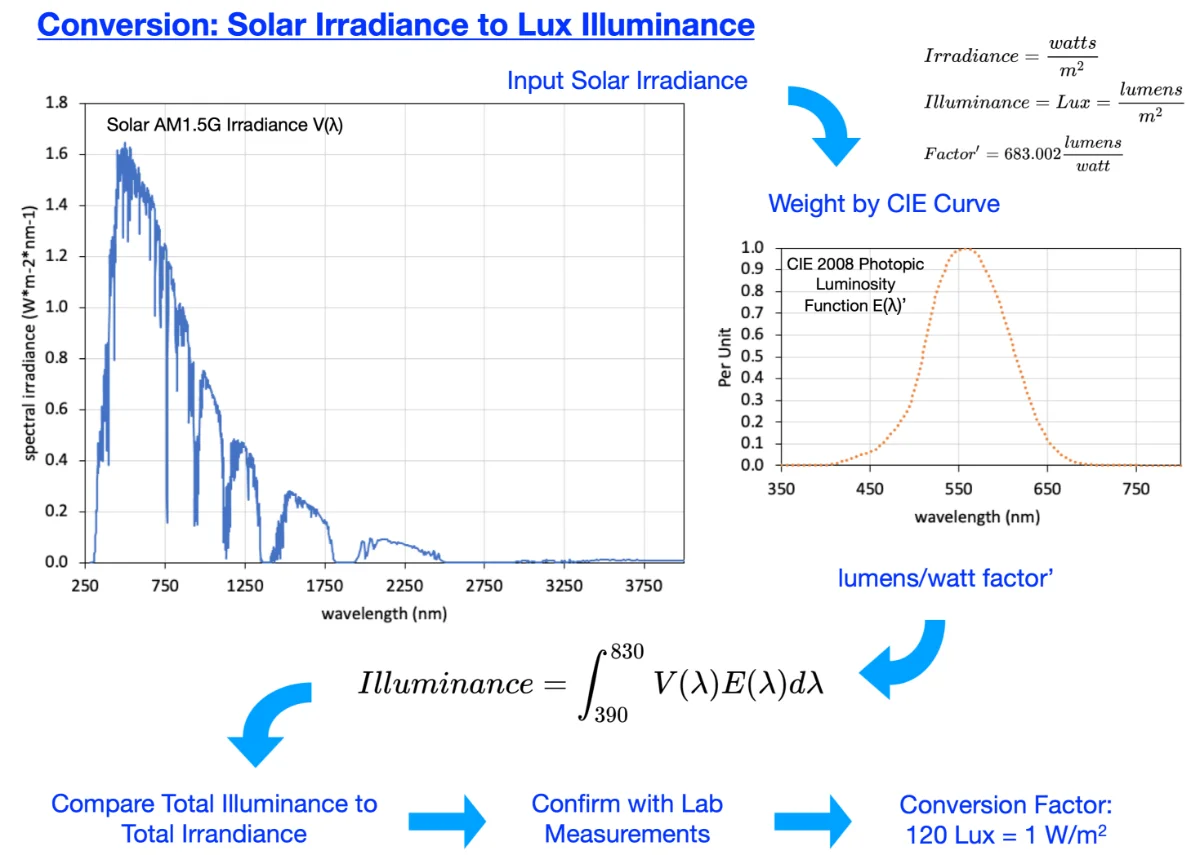
Most downloaded
Research Article
A conversion guide: solar irradiance and lux illuminance
By Peter R. Michael, Danvers E. Johnston, Wilfrido Moreno
The standard for measuring solar irradiance utilizes the units of watts per meter squared (W/m2). Irradiance meters are both costly and limited in the ability to measure low irradiance values. With a lower cost and higher sensitivity in low light conditions, light meters measure luminous flux per unit area (illuminance) utilizing the units of lumens per meter squared or lux (lx). An effective conversion factor between W/m2 and lx would enable the use of light meters to evaluate photovoltaic performance under low solar irradiance conditions. A survey of the literature found no definitive and readily available “rule of thumb” conversion standard between solar irradiance and illuminance. Easy-to-find Internet sources contain conflicting and widely varying values ranging from 688449 to 21000 lx for 1000 W/m2 (1 Sun) of solar irradiance. Peer-reviewed literature contains Luminous Efficacy equivalent values ranging from 21 to 131 lx per W/m2. This manuscript explores the relationship and establishes a theoretical and laboratory measurement guide for the conversion between solar irradiance and illuminance. The conversion factor includes standards data, equipment calibration accuracy, and uncertainty estimates. Solar Irradiance of 1 Sun (1000 W/m2) for an LED-based solar simulator is (116 ± 3) klx and (122 ± 1) klx for outdoor sunlight.
December 4, 2020
Applied Physics
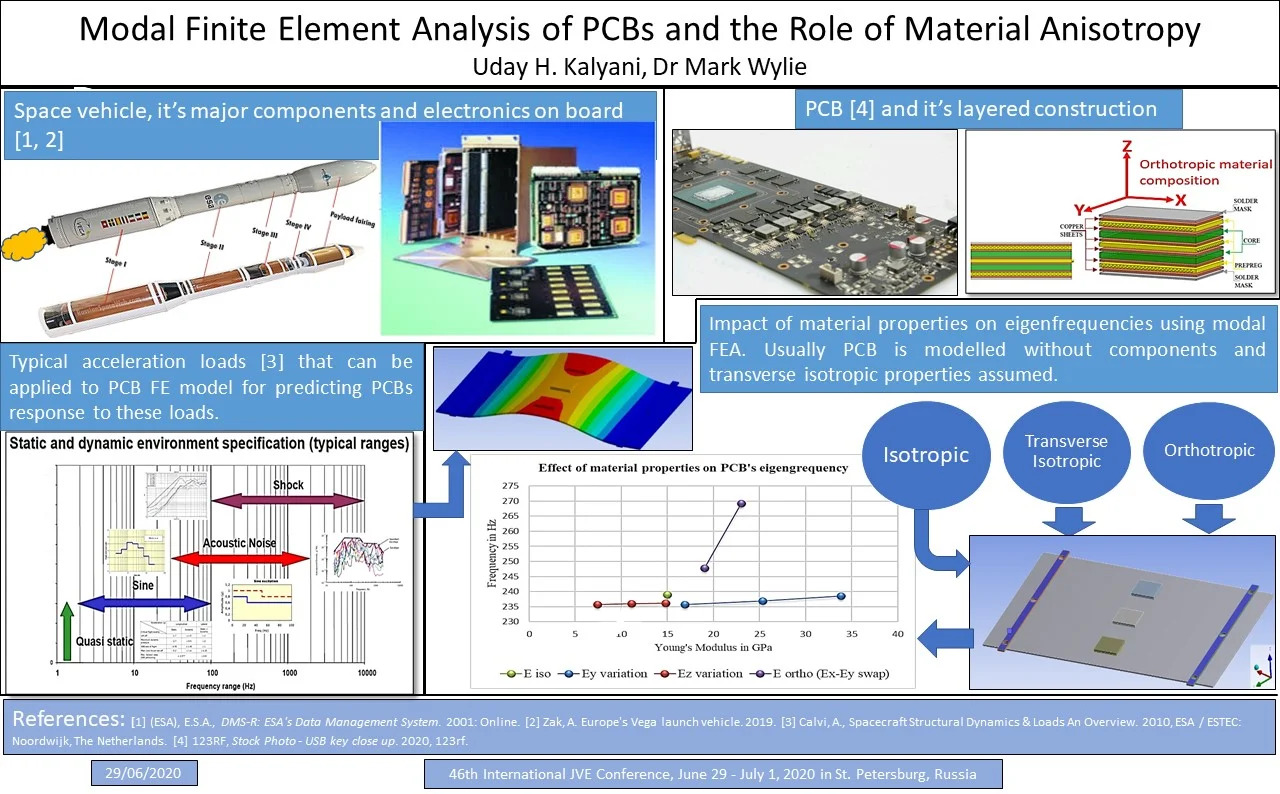
Most downloaded
Research Article
Modal finite element analysis of PCBs and the role of material anisotropy
By Uday H. Kalyani, Mark Wylie
Printed Circuit Boards (PCBs) are epoxy resin-impregnated and cured sheets of counter woven glass fabric (e.g. FR4) laminated between thin sheets of Copper. The nature of the PCB is inherently anisotropic and inhomogeneous but previous modal FEMs of PCBs have assumed isotropic, anisotropic (transversely isotropic and orthotropic) material properties and shown good correlation with test data for specific scenarios [1-3]. This paper details part of a research program aimed at gaining a better understanding of accurately modeling PCB’s dynamic behavior. New investigations into the impact of material anisotropy and, in particular, the effect of material orthogonal plane definition (Ex and Ey) on eigenfrequencies is analysed. A modal FEM of a JEDEC PCB is created, verified, and validated using well established theories by Steinberg and empirical data by others [4, 5]. The relative contributions of Ex, Ey and Ez on PCB eigenfrequencies is examined using a parametric modal FEM, analysing the role of material isotropy verses anisotropy. The impact of transversely isotropic material properties is also analysed for a typical JEDEC PCB. This analysis details the mesh density required for accurately modeling the PCB eigenfrequencies. The results show that a 100 % increase in Ez has only a 0.2 % difference in the eigenfrequency where as a 100 % increase in Ey has a 1.2 % difference in the eigenfrequency. The effect of orthotropic plane definition (alternating Ex with Ey) on the JEDEC PCB amount to a 7.95 % delta in eigenfrequency.
June 29, 2020
Vibration Engineering
Design and calculation of double arm suspension of a car
Suspension system is one of the challenging portions in designing a vehicle. The complete stability of the vehicle under dynamic conditions depends on the suspension system of the vehicle. Suspension system of a vehicle is interlinked with other systems such as steering, Wheels and Brakes. The main objective of this document is to provide complete guidance in designing and calculation of an independent suspension system with double control arms. The required parameters are calculated on considering a prototype vehicle with gross weight of 350 kg such as required stiffness of shock absorbers, Ride frequency, Motion ratio, Coefficient of damping etc. A CADD model was made with CATIA v5 r20 and SOLIDWORKS on the basis of calculations obtained and stress analysis was carried out for this model in various software such as Ansys. The complete assembled model was tested in LOTUS Shark and the result was obtained.
Coilgun design and evaluation without capacitor
Capacitors with high voltage and capacity values are used in most induction coilguns that are designed and constructed. The fact that capacitors are quite bulky and slow in energy transfer and how a coilgun can be made without using capacitors is the study subject of this article. Two and four coil gun samples were made to find the essential components of an electric gun, and the results are reported in this article. The accuracy of the results is also confirmed by FEMM analysis for these models. The harmony of experimental and theoretical results shows that smaller and low cost portable electrical weapons can be a powerful alternative to firearms in the future.